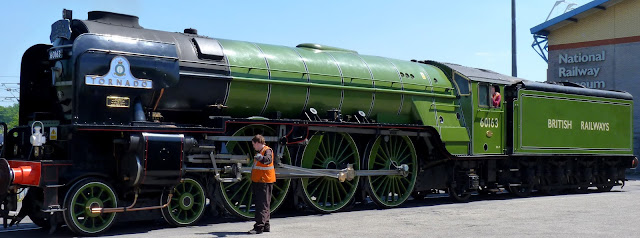The Easterling
Saturday 3rd October 2020
Join us on a journey by steam train to rural Norfolk and Suffolk, a scenic area of undulating farmland, market towns, picturesque villages and waterways.
The Easterling recalls the days of an express train that ran from London to Yarmouth and Lowestoft, taking Londoners to the Norfolk Broads and the famous East Anglian seaside resorts. The train will be hauled by A1 Class Pacific 60163 Tornado.
Our steam train will depart from London King’s Cross station at around 08:00 and immediately begins climbing through tunnels and cuttings as it makes its way up the East Coast Main Line (ECML). There are stops at Potters Bar and Stevenage for more passengers to join the train. At Hitchin, we leave the ECML and head for Cambridge, our final stop for passengers. We continue north to Ely and then take the Breckland Line through Thetford to Norwich. The Breckland area is of considerable interest for its unusual flora and fauna, and is characterised by gorse-covered sandy heath land and Scots Pine trees.
We arrive at Norwich around mid-day and our steam locomotive ‘runs round’ our train as we change direction of travel here. We continue our steam hauled journey taking one of the ‘Wherry Lines’ from Norwich to Lowestoft. The Norfolk Wherry is a type of boat that was widely used in the area. Lowestoft is the most easterly town in the UK and terminus for the East Suffolk Line (ESL). Our train stops here for well over an hour giving passengers time to explore the town and harbour, once a bustling fishing port.
Our return journey is along the 49 mile-long scenic ESL through Beccles, Saxmundham and Woodbridge, famous for having the only working Tide Mill in the UK, dating from 1793. Westerfield Junction is where the branch line from Felixstowe joins the ESL; the branch is heavily used by freight trains to and from Felixstowe Docks. Approaching Ipswich, we take the newly built ‘Bacon Factory Chord’ to join the Great Eastern Main Line (GEML) going northwards from London Liverpool Street to Norwich.
We continue northwards to Stowmarket and leave the GEML at Haughley Junction. We pass through Bury St. Edmunds station, with its distinctive pair of towers. At Snailwell Junction we take the line for Newmarket and Cambridge, where we stop to set down passengers. We make further stops to set down passengers at Stevenage and Potters Bar before journeys end at London King’s Cross.
Steam Hauled by A1 Class Pacific '60163 Tornado'
The original Peppercorn A1 series were ordered by the LNER, but the 49 locomotives were built at Doncaster and Darlington for British Railways (BR) in 1948–49, after the nationalisation of the railways in the United Kingdom. Following the modernisation and dieselisation plans of the 1950s, the A1 Peppercorn class was eventually scrapped at a comparatively early age of just 15 years.

Other famous East Coast Main Line steam locomotives have been preserved, for example, six Gresley LNER Class A4s, one LNER Class A3, 4472 Flying Scotsman, and one LNER A2 60532 Blue Peter but all 49 LNER Peppercorn Class A1 locomotives were scrapped. The last was 60145 St Mungo, which survived until September 1966. An effort was made to preserve 60145, but it failed due to a lack of proper funds. The original Peppercorn A1s were designed to cope with the heaviest regular post-war East Coast trains. The A1 Trust intended Tornado to be built from scratch, designed and built as the next locomotive in the A1 Peppercorn class, not as a replica or restoration project, but an evolution of the class incorporating design improvements that would have occurred had steam motive power continued on the mainline railway.
Tornado moved under its own power for the first time on 29th July 2008 at Darlington, and then spent two months at the Great Central Railway in Loughborough, where it was tested up to 60 mph (97 km/h) and operated its first passenger train. Tornado then moved to the National Railway Museum (NRM) in York for three test runs on the main line up to 75 mph (121 km/h). After repainting from works grey into LNER Apple Green, Tornado was approved for mainline passenger operation. On 31st January 2009 Tornado hauled its first passenger trip on the main line, The Peppercorn Pioneer, from York to Newcastle and back. By hauling various A1 Trust railtours, charters and other activities, Tornado will begin to recoup the estimated £800,000 debt from the project, which cost around £3 million.

No comments:
Post a Comment